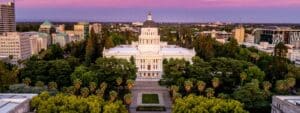Each year, Greenbelt Alliance selects priority state legislative areas to focus on that will guide our team in determining opportunities to take action on that will further our mission to educate, advocate, and collaborate to ensure the Bay Area’s lands and communities are resilient to a changing climate.
CENTERING EQUITY
We believe that policy decisions must prioritize attention, sustained resources, and solutions for the Bay Area’s low-income communities of color most vulnerable to the impacts of climate change. These are also communities that have traditionally been excluded––deliberately––from large scale investment and planning decision-making.
Advancing equitable climate resilience is part of advancing our society’s call for racial justice. Which is why Greenbelt Alliance is increasing our focus on ensuring our most vulnerable communities are centered in regional and local efforts to build climate resilience. We will drive our climate advocacy placing equity and anti-racism front and center.
2024 STATE LEGISLATIVE PRIORITY AREAS
For 2024, Greenbelt Alliance is focusing on the following priority areas within State Legislation:
Landscape-Scale Wildfire Risk Reduction and Long-term Resilience
California has a serious problem: extreme wildfire events growing more frequently under a changing climate. Such a complex problem requires significant, bold changes on many fronts. We seek to promote policy regulations that discourage new development in the Wildland Urban Interface (WUI), and further the creation and implementation of fire-safe land-use planning, design, and development standards (e.g. fire-safe road regulations) as well as promote incentives like transfer of development rights. We also believe it is critical to support further research and mapping related to WUI and high fire risk areas, land-use regulations, and wildfire insurance incentives. It is critical to encourage policies that promote nature-based solutions like greenbelt protections and forest and working land stewardship to prevent, mitigate, and prepare for wildfires at the community scale.
Climate Resilience Funding and Equitable Planning Integrating Climate Risks
Across the Bay Area, winters are becoming drier, summers bring more extreme heatwaves, and wildfires are a regular threat as are cycles of drought and major flood events. The Bay Area is grappling with how to handle these overlapping climate risks. We encourage legislation that will increase funding to help the State prepare, plan, and implement actions to address and adapt to the impacts of climate change. There needs to be additional technical support provided to local governments on adapting to climate impacts, including, but not limited to, sea level rise, flooding, wildfire, and drought. This new funding can also create additional jobs as well as create trainings for a green economy and green jobs with an emphasis on environmental justice with an equitable and just transition from the fossil fuel economy.
Open Space Protection and Stewardship; Nature-based Solutions
Our goal at Greenbelt Alliance is to conserve the Bay Area’s natural and agricultural landscapes while promoting climate-smart urban development that creates healthier, wildfire safe, diverse, and affordable communities. One of the most important policy tools that city planners can use to achieve this goal is the urban growth boundary, which circumscribes an entire urbanized area and is used by local governments to guide land-use decisions. We seek to encourage statewide urban growth boundary policies and prioritize the conservation of lands in high-risk areas to achieve fire resilience and protect places of high biodiversity. Building on the State of California’s 30×30 campaign, it is critical to unlocking funding and planning to meet 30% of lands protected by 2030. In doing so, we can enable urban greening, wetlands restoration, and other nature-based solutions.
Climate Mitigation on Natural and Working Lands
Resilient agriculture and working lands are essential to creating a resilient Bay Area. We seek to promote incentives for regenerative agriculture and carbon sequestration on working lands. We believe it is also critical to adopt legislation providing incentives for forest owners to learn and use best forest management practices that increase the ability of forests and soils to sequester more carbon than they do now.
Climate-smart Development
Climate change and the growing number of residents burdened by rising housing costs are the biggest threats to the Bay Area’s stability and vitality. Lack of housing exacerbates income inequality, disproportionately burdening low-income and communities of color. We promote legislation around planning and zoning changes that support infill development for all income levels, multi-family projects, increased mixed-use density, and development near transit and job centers. Increasing the production of housing is necessary to reduce the impacts of climate change, address the racial wealth gap, and build healthy, resilient communities. And because the housing shortage is rooted in a long history of racist planning practices, we are also promoting legislation that breaks down the systemic racist policies that hurt communities of color and puts them at greater risk of climate hazards.
MORE ON LEGISLATIVE PRIORITIES

2025 Legislative Session: Tackling the Dual Environmental and Housing Crises
Greenbelt Alliance is advocating for at least 11 bills in Sacramento to advance a climate-smart agenda. Get our legislative priorities.

Greenbelt Alliance Co-Sponsors SB79 To Expedite Transit-oriented Development
Greenbelt Alliance joins Senator Wiener to co-sponsor Senate Bill 79, an impactful new piece of legislation that would accelerate transit-oriented development.

2024 Legislative Session: Transportation and Housing Bills That Became Law
Updated on September 30, 2024 to reflect results. Originally published on August 16, 2024. California’s Congress adjourned the legislative session on August 31, and the results are in. This past year, we endorsed four bills, among Senate and Assembly pieces of legislation, three of which were successful in passing into law. Each year, Greenbelt Alliance
